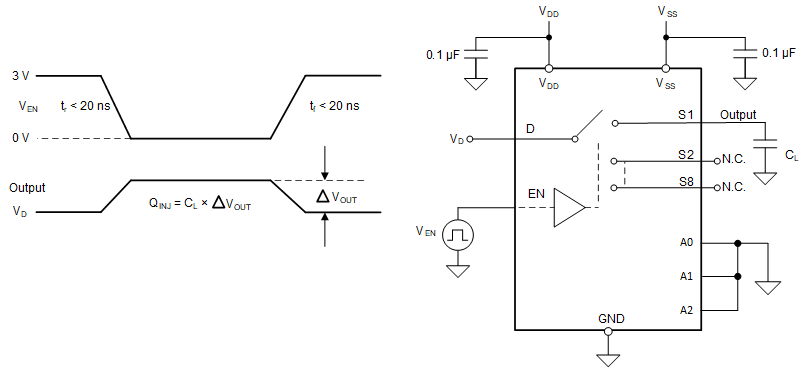SCDS418D July 2020 – September 2021
PRODUCTION DATA
- 1 Features
- 2 Applications
- 3 Description
- 4 Revision History
- 5 Device Comparison Table
- 6 Pin Configuration and Functions
-
7 Specifications
- 7.1 Absolute Maximum Ratings
- 7.2 ESD Ratings
- 7.3 Thermal Information
- 7.4 Recommended Operating Conditions
- 7.5 Source or Drain Continuous Current
- 7.6 ±15 V Dual Supply: Electrical Characteristics
- 7.7 ±15 V Dual Supply: Switching Characteristics
- 7.8 ±20 V Dual Supply: Electrical Characteristics
- 7.9 ±20 V Dual Supply: Switching Characteristics
- 7.10 44 V Single Supply: Electrical Characteristics
- 7.11 44 V Single Supply: Switching Characteristics
- 7.12 12 V Single Supply: Electrical Characteristics
- 7.13 12 V Single Supply: Switching Characteristics
- 7.14 Typical Characteristics
-
8 Parameter Measurement Information
- 8.1 On-Resistance
- 8.2 Off-Leakage Current
- 8.3 On-Leakage Current
- 8.4 Transition Time
- 8.5 tON(EN) and tOFF(EN)
- 8.6 Break-Before-Make
- 8.7 tON (VDD) Time
- 8.8 Propagation Delay
- 8.9 Charge Injection
- 8.10 Off Isolation
- 8.11 Crosstalk
- 8.12 Bandwidth
- 8.13 THD + Noise
- 8.14 Power Supply Rejection Ratio (PSRR)
- 9 Detailed Description
- 10Application and Implementation
- 11Power Supply Recommendations
- 12Layout
- 13Device and Documentation Support
- 14Mechanical, Packaging, and Orderable Information
8.9 Charge Injection
The TMUX7208 has a transmission-gate topology. Any mismatch in capacitance between the NMOS and PMOS transistors results in a charge injected into the drain or source during the falling or rising edge of the gate signal. The amount of charge injected into the source or drain of the device is known as charge injection, and is denoted by the symbol QINJ. Figure 8-9 shows the setup used to measure charge injection from source (Sx) to drain (D).
 Figure 8-9 Charge-Injection Measurement Setup
Figure 8-9 Charge-Injection Measurement Setup